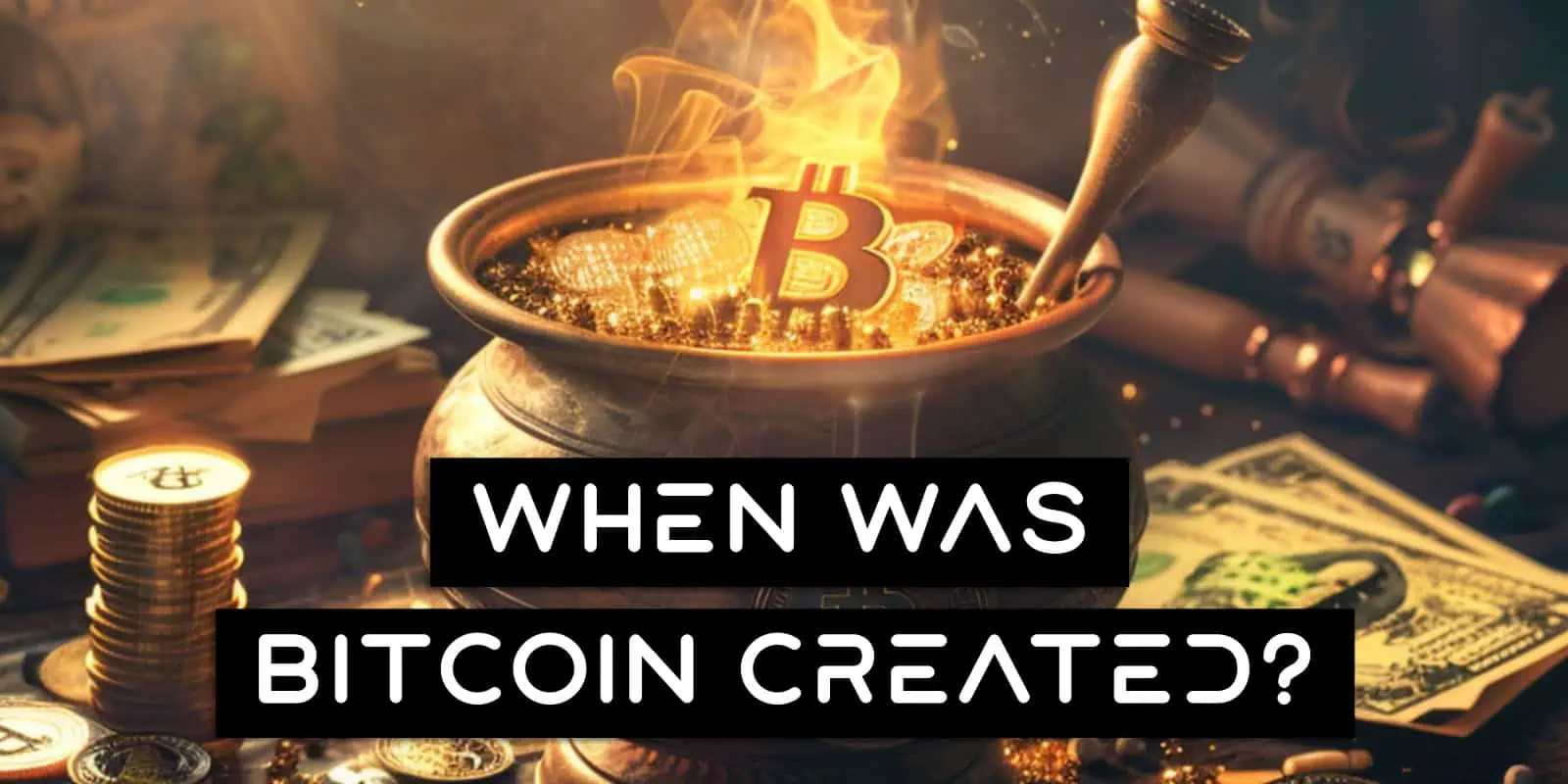It’s hard to imagine a time when the concept of virtual currency wasn’t a thing, but that’s exactly what it was like pre Bitcoin. Today, we’re going to find out when Bitcoin was created, as it’s not really just one specific date but multiple ones, take you through a brief journey back in time and explore the fascinating history of Bitcoin as well as what’s in store for cryptocurrency transactions of the future.
Contents
When Was Bitcoin Created?
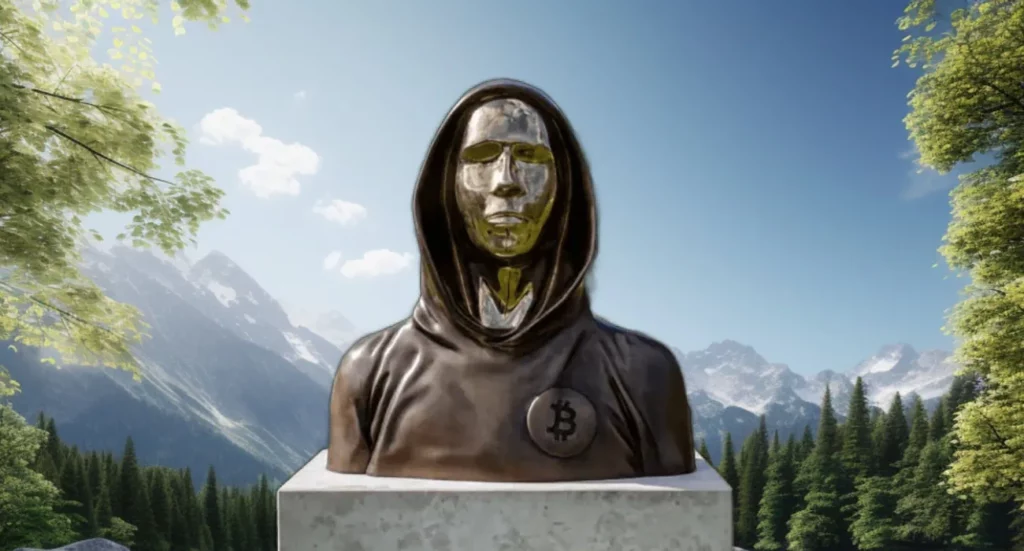
Satoshi Nakamoto released the famous Bitcoin Whitepaper in October of 2008. After this it took Satoshi a while to finish writing the Bitcoin Core code, then on the 3rd of January, 2009 the first Bitcoin block was mined, called the “genesis block” or Block 0.
They continued working on the project with other developers until 2010 when they left the project. To this day it’s still not know who this person or persons were. It’s estimated that they mined at least 1.1 million bitcoins between January of 2009 and January of 2010 which would now be worth tens of billions of dollars.
Why Was Bitcoin Created?
Bitcoin was created to be an online version of physical cash. A digital form of cash that removes the need for trusted third parties like banks or other intermediaries like PayPal or central banks. The original whitepaper is literally titled “Bitcoin: A Peer-to-Peer Electronic Cash System“.
When discussing this “trust”, two different types were explicitly referred to:
- Trust in intermediaries like banks or other financial institutions
- Trust in central banks like the Federal Reserve or European Central Bank
Bitcoin removes the need to trust either of these types of institutions and allows two people, anywhere in the world, to transact in a purely peer-to-peer fashion. You send your value to the other person. No permission, no accounts, no way for anyone to stop it. All open, transparent, fair and online by default.
Removal of trust in banks or other financial institutions means that they’re no longer required to complete basic financial transactions. You can get blocked by all the banks in your country, PayPal, Venmo etc and still be able to pay your employees, buy your coffee or save for your future.
As Bitcoin is also separate from the central banks of the world it also means you’re protected from their inflation. Central banks around the world routinely “revalue” their countries currencies, making them worth less and stealing wealth from all their citizens.
This can come in huge amounts, 50% for example, or be more insidious at “only” 2-3%. Even at this lower end of 2%, this means that the value of your money will be halved every 35 years. Bitcoin allows you to opt out of this silent theft and instead save in a currency that will never be debased or steal from you. Ever.
>> Deeper Dive: Why Was Bitcoin Created?
Bitcoin, A Short History

Since Bitcoin was created, many software developers have tried to hard fork Bitcoin for various reasons. Sometimes this was to fix perceived flaws in the code, while other times it was for purely selfish reasons.
While the terminology might sound a bit weird, Bitcoin Forks are just changes in software code which most people deal with on a daily basis. From updating the apps on your phone to having to sit and wait the 10 hours for your computer to do those dreaded Windows Updates, it’s not anything new or complicated.
Only two very minor Bitcoin hard forks have ever succeeded, these were:
- BIP-0050 (2013)
- CVE-2018-17144 (2018)
In contrast, here are just some of the dozens of failed ones:
- Bitcoin XT (2014)
- Bitcoin Classic (2016)
- Bitcoin Unlimited (2016)
- Bitcoin Diamond (2017)
- Bitcore (2017)
- Bitcoin God (2017)
- Super Bitcoin (2017)
- Bitcoin Cash (2017)
- Bitcoin Gold (2017)
- Bitcoin Private (2018)
- Bitcoin Atom (2018)
- Bitcoin Zeo (2018)
- Bitcoin Post-Quantum (2018)
- Bitcoin Satoshi’s Vision (2018)
Over this time all these Bitcoin clones came out Bitcoin has had numerous massive exchanges collapse, online marketplaces come and go, an entire mining and wallet business arise and more play out. From face melting 3,900% price increases to the Block Size wars it’s been and continues to be a wild ride!
New to Athena Alpha? Start today!
Pre History Of Bitcoin
While many think that Satoshi just pulled Bitcoin out of no where, the truth is that they were in fact standing on the shoulders of giants. The technologies that enable Bitcoin were built and worked on by hundreds of people over the course of decades prior to its inception in 2009.
From basic public and private key cryptography that has been around since the 1970’s, to multiple different forms of “digital currency” or electronic money, Satoshi was clearly building on what had come before.
Some early attempts at a digital currency include:
- DigiCash / eCash (1989)
- CyberCash (1994)
- E-gold (1996)
- Hashcash (1997)
- B-money (1998)
- WebMoney (1998)
- Liberty Reserve (2006)
- Perfect Money (2007)
- Bit Gold (2008)
All of these failed for one reason or another and helped set the stage for Bitcoin to flourish. For example, Hashcash helped lay the foundation for what we now know as Proof-of-Work (PoW) and Bitcoin Mining.
These failed attempts also show that Bitcoin wasn’t just some magic lightning bolt that came from the sky, but instead was the result of continued trial and error on the part of many different people.
The Disappearing Satoshi
For a few years Satoshi spoke back and forth with developers and others on the Bitcoin forum as well as managed the general Bitcoin Core software. Bitcoin grew quickly over this short time frame and then on the 26th of April, 2011 they disappeared forever, only making one other comment in 2014 to say they weren’t Dorian Nakamoto (the person in the above photo). Although they created the entire Bitcoin industry, they selflessly excused themselves and have never returned.
Other developers took over Bitcoin Core and the community as well as other bitcoin enthusiasts have steered it ever since, always staying true to the initial bitcoin ideology. The fact that Satoshi disappeared has actually turned out to be one of the greatest parts of Bitcoins creation for multiple reasons.
For one, it means that Bitcoin has a truly immaculate conception (of sorts). There is no head, no lead developer, no inventor, no company, no VCs, no country, no government or anything else that “heads” or “owns” bitcoin. It is as independent as gold or oil or a piece of land is.
Mt. Gox: The First Bitcoin Exchange
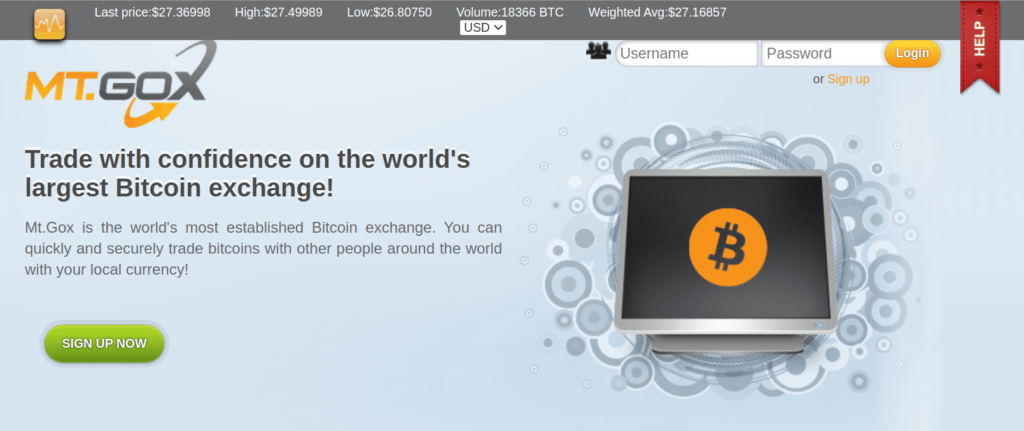
After a few years of gaining traction Bitcoin began to be used more and more and on the 18th of July, 2010 the Bitcoin exchange Mt. Gox was created. Mt. Gox, which stood for Magic: The Gathering Online eXchange, was based in Tokyo and grew to eventually encompass over 70% of all bitcoin transactions.
Originally built to trade Magic: The Gathering cards, the programmer Jed McCaleb decided to alter it to instead exchange bitcoin after reading about it online. The new bitcoin exchange allowed users to view Bitcoin’ prices against other traditional currencies and was the first major cryptocurrency market.
After growing to be the dominant exchange it abruptly ceased operations on the 7th of February, 2014 when it halted all withdrawals. Over the following weeks Mt. Gox released statements and tried to “fix” the issue, but eventually it was revealed that they had in fact lost almost 750,000 of its customers bitcoins.
This enormous sum of bitcoin (roughly 3.5% of all bitcoin to ever exist) was valued at ~$473 million at the time and started what has unfortunately become an ongoing trend of Crypto Exchange Bankruptcies that still continues to this day.
Take this as yet another reminder to get your coins off of those exchanges!
Silk Road
In February of 2011, Ross Ulbricht under the pseudonym “Dread Pirate Roberts” started an online marketplace named Silk Road where users could buy and sell bitcoin in exchange for goods.
Silk Road was created to give people the freedom to transact, buy and sell on their own terms according to Ross, however it quickly turned into a haven for drugs, guns, money laundering and other deeply disturbing behavior.
Federal law enforcement eventually caught on, investigated the site and arrested Ulbricht on the 2nd of October, 2013. He is now serving multiple life sentences and the name Silk Road is synonymous with illegal activities and “drug money”. It’s also a huge part of why many to this day still believe the Bitcoin Myth that Bitcoin is “only used by criminals”.
Blockchain Technology
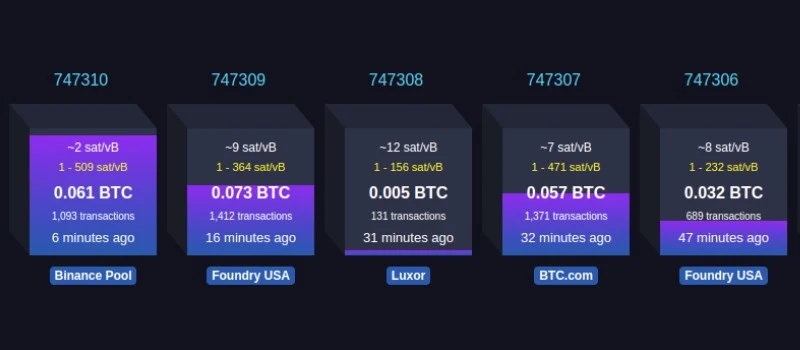
Key to Bitcoin is the Bitcoin Blockchain. A blockchain is a distributed database, also referred to as a distributed ledger, that’s shared between many nodes on a network. They are most commonly used in cryptocurrency networks, but they have been used for other things too. The data that’s stored in a blockchain is Immutable, meaning that it can never be changed.
Let’s break down some of those key terms to further clarify that paragraph:
- Blockchain: A type of database or file, similar to an Excel spreadsheet
- Distributed: This means there is more than one copy stored throughout the world
- Node: Any computer or server that runs the software and is part of the blockchain network
- Immutable: This means that the data can never be altered or deleted
In order to keep track of who owns what tokens or coins, cryptocurrencies use blockchain technology. This big database or file is constantly updated to show who owns what. For example it might say “Bill owns 1 bitcoin”.
Use Cases And Applications
Beyond simply speculating on the price, Bitcoin has a huge array of other extremely important use cases. For starters, the main reason Why Bitcoin Was Created was to be an online version of physical cash. A digital form of cash that removes the need for trusted third parties like banks or other intermediaries such as PayPal or central banks.
This means that as the world pushes more and more into the digital realm everyone is free to retain their privacy and independence from overreaching governments or businesses. If one day physical cash is removed from your country and all that remains is draconian “digital dollars” run by your governments central bank, you can choose to instead use an open and transparent alternative that’s private and secure.
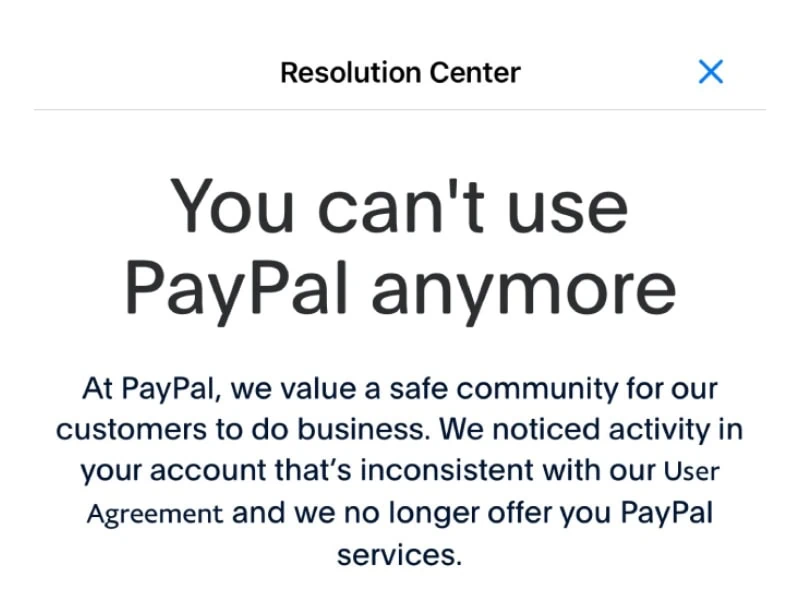
You won’t need to trust a government, a bank or even a company. You won’t be able to be debanked or have your financial accounts shut down. You won’t have your wealth debased or inflated away by a government trying to win the next election or make money for its friends. Bitcoin gives all of us this choice to opt out.
You can also:
- Spend your bitcoins at millions of places all over the world
- Store monetary value without anyone’s permission
- Store monetary value beyond the reach of a government
- Send money overseas instantly and cheaply
- Send free and instant Remittance
- Transact without being banned as mentioned
- Take your wealth with you when fleeing a country
Bitcoin Mining
Mining is the process of adding transactions to the Bitcoin Blockchain. Miners are then rewarded with the Block Reward and all the transaction fees within that block.
Proof-of-Work (PoW) mining also performs two other critical functions in the Bitcoin network:
- Secures the network from attackers
- Issues / mints new bitcoins in a fair, automatic and distributed way
Right from the start mining bitcoin has always been a core part of the Bitcoin network. In order to process a bitcoin transaction there needs to be work done and the mining process is not just how it’s done, but how the network as a whole is secured as well.
Throughout its history, bitcoin mining has grown to consume more hashing power and more electricity. Bitcoin Mining is a fairly nuanced topic and as such, most people who don’t properly understand it simply dismiss it as “wasteful” due to its rather large energy requirements.
This misguided notion of mining being “a waste” has been a huge part of bitcoins history for over a decade now and has only been made worse with the onslaught of Climate Change. How it works, the game theory that’s involved in it and Satoshi’s introduction of the difficulty adjustment mechanism are all pivotal in what makes bitcoin so amazing.
Originally mining was done on simple laptop CPUs as the hashing power required to mine a new block wasn’t anything huge. After a while people started using GPUs as they can calculate hashes much faster, but since around 2013 it’s only possible to mine using custom designed pieces of hardware called application-specific integrated circuit or ASICs.

In July of 2014, one of the most popular mining pools Ghash.io briefly exceeded the 51% threshold enabling it to (in theory) execute a 51% attack. This style of attack could allow them to double spend bitcoin in what’s known as the Double Spending Problem. The price of Bitcoin dropped after this new threat was circulated and when the prominent bitcoin developer Peter Todd sold half of all his bitcoin.
In March 2015, Ghash.io was hit with a DDoS attack which resulted in them ceasing mining activity by the end of 2015. Since then, no other miner or mining pool have ever gained a greater than 51% share in the hashing power.
Bitcoin Mining can also be useful in many interesting and non-intuitive ways. This can be anything from using the excess generated heat to warm up your home or heat green houses right through to using it as a powerful demand response mechanism that increases grid resiliency. Individual users all around the world can even participate in Bitcoin Lottery Mining too!
There’s even a huge new field where Bitcoin Mining is helping to encourage (oil) mining operations or city councils to burn off excess methane emissions to reduce climate change.
Bitcoin Price History And Volatility
Throughout its history Bitcoin has been an extremely volatile asset. Bitcoin volatility is still to this day very high with a price that changes every second, every day as it’s tradable globally 24/7/365. That being said, it’s also the best performing asset by a huge margin over the past 10 years. Its Compound Annual Growth Rate (CAGR) is astronomical at about 50% with its growth being off the charts.
| Year | Start | End | Return |
|---|---|---|---|
| 2009 | $0 | $0 | 0% |
| 2010 | $0.0025 | $0.10 | 3,900% |
| 2011 | $1 | $30 | 2,900% |
| 2012 | $5.31 | $14 | 164% |
| 2013 | $20 | $755 | 3,675% |
| 2014 | $767 | $317 | -59% |
| 2015 | $314 | $431 | 37% |
| 2016 | $434 | $960 | 121% |
| 2017 | $998 | $14,839 | 1,387% |
| 2018 | $14,093 | $3,809 | -73% |
| 2019 | $3,692 | $7,240 | 96% |
| 2020 | $7,244 | $28,837 | 298% |
| 2021 | $28,665 | $48,022 | 67% |
| 2022 | $48,082 | $16,540 | -66% |
| 2023 | $16,541 | $42,208 | 155% |
| 2024 | $42,208 | $93,508 | 122% |
| 2025 | $93,508 |
This amazing performance has also gained the attention of traditional finance (TradFi) bringing huge amounts of capital inflows through new financial instruments such as ETFs. We’re now seeing the worlds biggest asset holder BlackRock run massive conferences and educational seminars to teach financial institutions and advisors about the asset and how to position it in their clients portfolios.
Bitcoin Futures And ETFs

In January, 2024 the SEC finally approved 11 different spot Bitcoin ETFs. What most people refer to when they mention a Bitcoin ETF is one that tracks the spot price of Bitcoin. The spot bitcoin price in simple terms is just the current market price of bitcoin and a spot Bitcoin ETF should directly hold actual Bitcoin in its portfolio on behalf of the ETF holders.
Having Bitcoin represented in an ETF enables investors of all types like pension funds, businesses and institutional investors to quickly and safely gain exposure to Bitcoin and its underlying market without having to deal with taking self custody of it themselves.
Futures on the other hand are contracts that allow more sophisticated investors to bet on the future price of Bitcoin. While these haven’t been approved yet, there’s news that they may be quite soon. Many also feel that futures will be an enormous market and greatly increase the price of Bitcoin as it can create a feed back loop.
A Incredibly Bright Future
While there’s even more to Bitcoin’s history, such as bitcoin trading, bitcoin software, the evolution of a bitcoin address, the bitcoin blockchain and especially the countless cryptocurrency exchanges that have failed causing huge devastation, its future is exceptionally bright.
As the biggest, most secure, most widely recognized and decentralized of the digital currencies it seems to be all major companies and investment institutions are legitimately interested in. More places accept bitcoin than any other digital currency, interest in an Ethereum ETF is essentially none and this once small project by Satoshi Nakamoto has gone on to spawn multiple hundred billion dollar industries that are thriving.
Its an entirely digital store of value with a fixed supply that you can transport instantly anywhere in the world and secure in a million different ways with near zero ongoing costs and no upkeep. More people are wanting to buy bitcoin than ever before with a number of new and existing big core software upgrades enabling some truly amazing new use cases for the global economy.
From the Lightning Network to Silent Payments to new Mining use cases to any number of new hardware or software wallets Bitcoin has a bigger, more diverse and more excited ecosystem now than ever before. Its future is big, bright and seemingly unstoppable. We can’t wait to see where we’ll be in another 15 years!
FAQ
How Much Is 1 Bitcoin In 2009?
In 2009 Bitcoin’s price was essentially $0. There wasn’t even a Bitcoin exchange until mid 2010 as it was still in heavy development by both Satoshi nakamoto and others in the cypherpunk community.
When Was Bitcoin $1 Dollar?
Bitcoin’s value first hit $1 around April of 2011. At the start of 2011 it was valued at about $0.30 per bitcoin. Throughout 2011 it then soared up to almost $30, only to then crash back down to $4.72 by the end of 2011
Was Bitcoin Founded In 2008?
Satoshi Nakamoto released the famous Bitcoin Whitepaper in October of 2008. After this on the 3rd of January, 2009 the first Bitcoin block was mined, called the “genesis block” or Block 0.
How Much Will 1 Bitcoin Be Worth In 2030?
There are many models or predictions out there for what Bitcoin will be worth by 2030. The Bitcoin Power Law predicts around $500,000 USD per bitcoin, while the Bitcoin Rainbow Chart predicts around $400,000 USD per bitcoin. Obviously these are just guesses and no one really actually knows.

